The Intel Broadwell Desktop Review: Core i7-5775C and Core i5-5675C Tested (Part 1)
by Ian Cutress on June 2, 2015 7:45 AM ESTOffice Performance
The dynamics of CPU Turbo modes, both Intel and AMD, can add a wrinkle to testing in environments with a variable threaded workload. There is also an added issue of the motherboard remaining consistent, depending on how the motherboard manufacturer wants to add in their own boosting technologies over the ones that Intel would prefer they used. In order to remain consistent, we implement an OS-level unique high performance mode on all the CPUs we test which should override any motherboard manufacturer performance mode.
All of our benchmark results can also be found in our benchmark engine, Bench.
Dolphin Benchmark: link
Many emulators are often bound by single-threaded CPU performance, and general reports tended to suggest that Haswell provided a significant boost to emulator performance. This benchmark runs a Wii program that raytraces a complex 3D scene inside the Dolphin Wii emulator. Performance on this benchmark is a good proxy of the speed of Dolphin CPU emulation, which is an intensive single core task using most aspects of a CPU. Results are given in minutes, where the Wii itself scores 17.53 minutes.
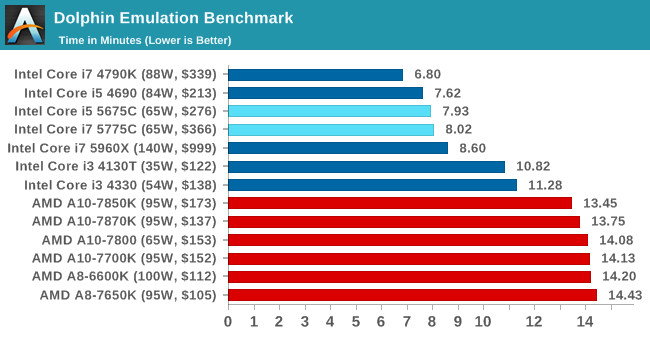
Crystal Well doesn’t help much in Dolphin, indicating it is more CPU frequency limited than DRAM/cache limited.
WinRAR 5.0.1: link
Our WinRAR test from 2013 is updated to the latest version of WinRAR at the start of 2014. We compress a set of 2867 files across 320 folders totaling 1.52 GB in size – 95% of these files are small typical website files, and the rest (90% of the size) are small 30 second 720p videos.
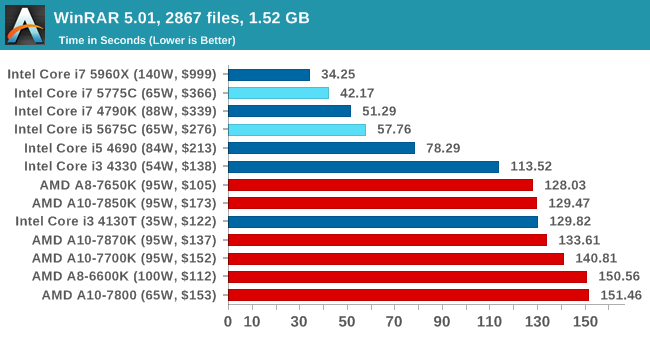
WinRAR is our typical benchmark to go to when testing whether DRAM is factor, and the improvements provided by the Crystal Well implementation trump any frequency deficit.
3D Particle Movement
3DPM is a self-penned benchmark, taking basic 3D movement algorithms used in Brownian Motion simulations and testing them for speed. High floating point performance, MHz and IPC wins in the single thread version, whereas the multithread version has to handle the threads and loves more cores.
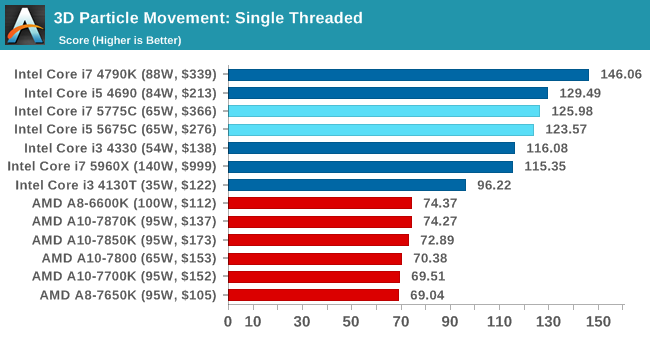
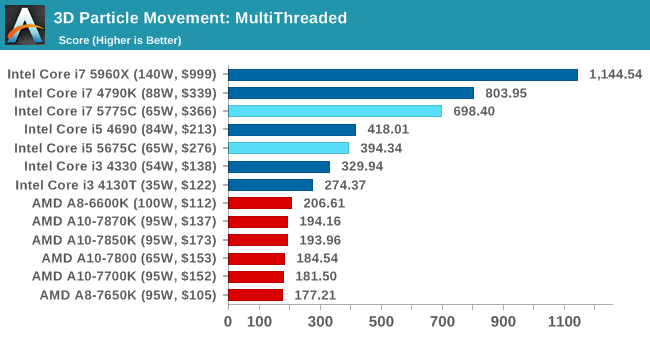
3DPM, like Dolphin, is concerned more with CPU frequency than DRAM accesses.
FastStone Image Viewer 4.9
FastStone is the program I use to perform quick or bulk actions on images, such as resizing, adjusting for color and cropping. In our test we take a series of 170 images in various sizes and formats and convert them all into 640x480 .gif files, maintaining the aspect ratio. FastStone does not use multithreading for this test, and results are given in seconds.
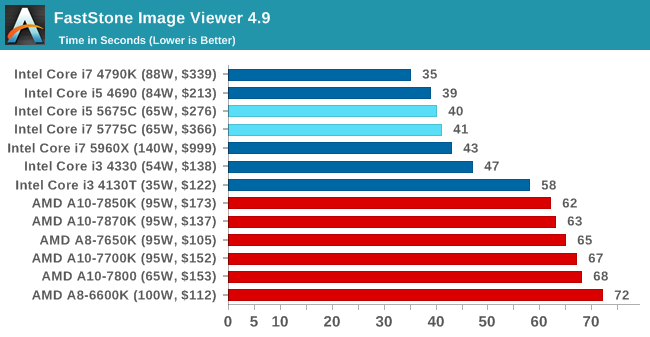
Web Benchmarks
On the lower end processors, general usability is a big factor of experience, especially as we move into the HTML5 era of web browsing. For our web benchmarks, we take four well known tests with Chrome 35 as a consistent browser.
Mozilla Kraken 1.1
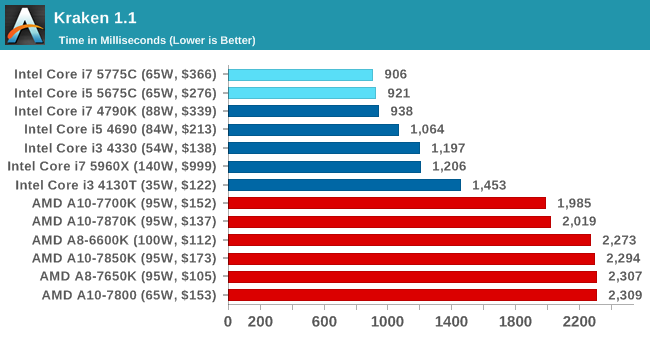
WebXPRT
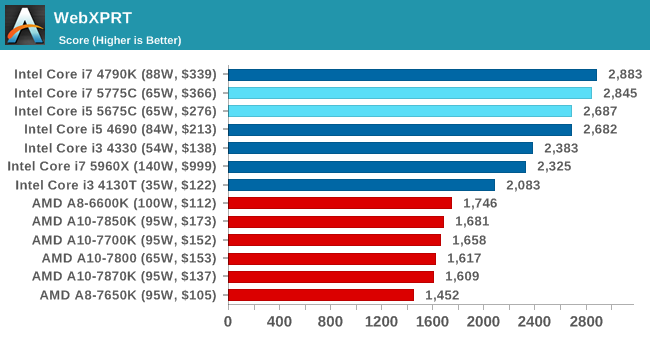
Google Octane v2

In the webtests, the Broadwell-DT CPUs didn’t necessarily take top spot but they are punching above their expected weight for their frequency.










196 Comments
View All Comments
Gothmoth - Tuesday, June 2, 2015 - link
well we can dream.i could use more cores.
i use heavy multithreaded applications and do heavy multitasking.
yet i have to live with 10% better performance per cpu generation. :(
haswell-e is the only choice when i want to upgrade.
but it runs hot and i have no use at all for internal graphics.
so why not making another CPU tailored for people like us?
i mean intel makes enough different CPUs anyway.
Gothmoth - Tuesday, June 2, 2015 - link
ah that reads wrong... i know that haswell-e has no internal graphics.what i meant was... haswell-e runs hot and for the other cpus like broadwell i have no use of the internall GPU.
DCide - Tuesday, June 2, 2015 - link
All this wishful thinking on your part tells me you probably don't have a very strong, actual NEED. Because if you did, you'd be ecstatic about the 5820K or 5960X. They run at 4GHz all day long with standard air cooling and no knowledge of overclocking (I just use ASRock's SLOWEST default overclock settings in the BIOS setup).It's almost humorous when I read these benchmarks, because they so understate the true, completely stable performance of the 5960X without doing any extra work setting it up. It's nearly twice as fast as the 4790K in practice (in fact it *is* about twice as fast when you consider how easily and quickly the 4790K throttles in a typical configuration).
I realize there are situations where generating more heat in the room matters. But if your multitasking were genuinely heavy enough to warrant the upgrade to 6 or 8 cores, you'd be foolish not to take advantage of the great solution that's available right now.
MrSpadge - Tuesday, June 2, 2015 - link
Double the cores means double the power consuption. There's no way around this, except making each core run slower.. which diminishes the benefit of having them. If Haswell-E runs too hot for you, no other chip Intel would reasonably want to produce right now would satisfy you.nikaldro - Tuesday, June 2, 2015 - link
But haswell-E is still on 22nm, not 14nm.nevcairiel - Tuesday, June 2, 2015 - link
Then wait for Broadwell-E.Azurael - Tuesday, June 2, 2015 - link
Why would you want to invest in 3 sticks of DDR4 RAM which will bring nearly no performance benefit and a massively overpriced motherboard for an extra couple of cores? It's not the cost of the Haswell-Es, or even their power consumption that bugs me - I suspect dual channel DDR3 is perfectly adequate for 6 cores alone given that it is apparently adequate for 4+GPU.Still, it makes my investment in a 2500K which has been running at 4.5GHz on stock voltage for the last 3 and a half years on the cheapest Z68 board I could buy sound rather good. I think I'd struggle to gain more than 20% in performance for the outlay of buying a new motherboard and CPU. I built a 4770K-based rig for a friend last year, it won't scrape past 4.2GHz. I'm sure IPC + HT + Faster RAM makes it faster than my rig, but certainly not in any noticeable fashion.
DCide - Tuesday, June 2, 2015 - link
Obviously it wouldn't matter to you. You didn't even bother to go with an i7.But for those to whom it does matter it's the biggest step up we've seen in a desktop CPU in a long time. The additional RAM and motherboard cost is trivial to those for whom the extra performance provides more than amusement.
Azurael - Tuesday, June 2, 2015 - link
You're correct - to me, it seems adequate for video editing and running Android builds... I'm sure in your 'elite' i7 world, things are far quicker. My issue is not with the fact that Intel offers higher spec or more expensive parts. Obviously, there would be no need for 18-core Xeons in this hypothetical world. My issue the fact that they artificially constrain the 'mid' range dual channel architecture to 4 cores and lump us with an IGP that's never going to get used taking up more die space than the extra couple of cores would just because they don't have any competition.Azurael - Tuesday, June 2, 2015 - link
And by the way, a ~84W TDP CPU is going to throttle when overclocked - especially when running AVX loads. If you haven't found the current limits in the BIOS, you probably deserve to believe your expensive 6-core running at only 4GHz is twice as fast as a properly set up 4790K :P